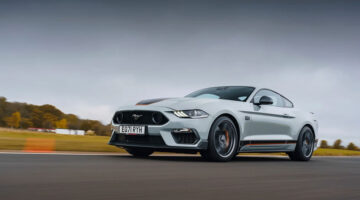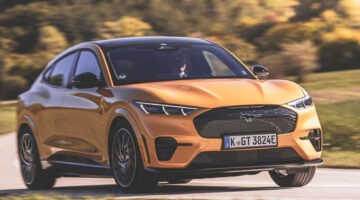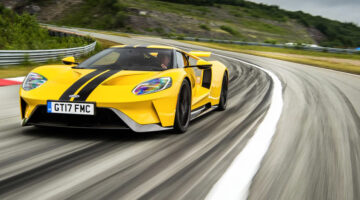Twenty years ago the first generation Ford Focus marked a seminal point in both Ford’s history and that of the family hatchback class. After more than a decade of stodgy Escorts, the Focus’ sharp chassis and even sharper styling were a revelation. Following on from the similarly improved Fiesta, Mondeo and the then-new Puma, the original Focus cemented Ford’s reputation as a builder of everyday driver’s cars.
Each subsequent Focus generation has fallen slightly away from that high point (though five-cylinder STs and increasingly wild RSs have made up for it), but Ford hints that the latest car is much closer in ethos to that first generation model. Fresh from launching the excellent new Fiesta ST but with the Focus ST still in development, we’ve driven the sportiest current Focus – the ST-Line – to see if the magic has returned.

Engine, transmission and 0-100 time
Four basic engines are available in the new Ford Focus, with 1-litre and 1.5-litre three-cylinder petrols, and 1.5-litre and 2-litre four-cylinder diesels, all turbocharged.
We’re concentrating on the top 180bhp, 273lb ft 1.5-litre petrol here, essentially a detuned version of the engine found in the new Fiesta ST. While 1-litre EcoBoost petrols have previously felt a little under-nourished for a car the size of the Focus, the same can’t be said of the 1.5 – it is, after all, only a small way off the horsepower that hot hatchbacks of this size had not so long ago.
It’s good for a 0-100kph time of 8.3sec (8.5 for the estate), making it the quickest new Focus so far (by a couple of tenths to the 148bhp diesel) but it’s by far the most pleasant engine to use. It takes some stoking to get going, with little enthusiasm below about 2000rpm (peak torque is supposedly at 1600rpm), but beyond this point boost builds quickly and there’s then a linear surge all the way to the 6000rpm power peak.

The three-cylinder burble is relatively subdued – we’d actually welcome just a little piped-in sound in an ST-Line-badged car, though we can’t fault the refinement. The engine is responsive to the throttle, too, which isn’t always a given with three-pots. If there’s a black mark it’s another three-cylinder trait, with some rev-hang when you’re trying to effect quick gearchanges, but at least the shift itself is excellent – a development of Ford’s existing 6-speed manual, changes are smooth and precise.
Technical highlights
ST-Line Focuses retain independent suspension all-round, with MacPherson struts up front and a multi-link setup at the rear, but for the first time lower-power variants get a torsion beam rear end. Regardless of the suspension setup the bodyshell’s torsional rigidity is 20 per cent better than before and Ford has used “structural foam” in some cavities to further increase rigidity – up to 10 per cent in localised areas.
The ST-Line also gets a 10mm lower ride height than its stablemates (the crossover-style Focus Active, on the other hand, is 30mm higher than standard), then there are different damper settings, stiffer springs and revised anti-roll bars. Wheels are 17in and tyres are 215/50 R17 Continental ContiSportContacts.

What’s it like to drive?
Conventional, non-performance cars have become so competent in the last decade or so that it’s difficult finding ones that corner or perform with anything other than studious obedience to your commands and a distinct lack of fun.
The Focus is not one of those cars, and probably sets the dynamic benchmark in this class right now. It’s an improvement over its slightly disappointing predecessor, and makes you wonder why companies like Audi and Mercedes-Benz, with all the resources at their disposal, can’t deliver a ride and handling balance that gets anywhere close to a car costing thousands less.
The steering is a strong point. It feels light at first but the weighting is consistent and builds naturally through corners, delivering a reasonable approximation of feedback, quick (but not hyperactive) responses to your inputs, and a precision that lets you control the car’s direction confidently from corner entry to exit. At the same time, it remains unaffected by torque steer or mid-corner bumps, as well as being light enough around town and stable enough on the motorway. While not the last word in interaction, it’s about as good as you’ll find in a conventional car, though it’s worth turning off the irritating Lane Centring technology that can nudge the wheel this way and that if it feels you’re too close to road markings.

As is the chassis itself. Positive turn-in is followed by strong mid-corner grip, but the Focus is also adjustable enough that you can tighten the car’s line and eventually rotate the rear end as you back off the throttle. Feed in the power and you get the reverse – stability, followed by gradual, well-telegraphed understeer.
You don’t notice the ride at first – always a good sign. In ST-Line trim it’s firm but not uncomfortably so, and the damping has an expensive feel that deals with bumps without transmitting any harshness or noise to the already refined cabin. Body control is excellent too, unfazed by quick changes of direction. There’s roll, but the welcome kind that helps you build up to the tyres’ limits gradually.
Best of all, all these factors come together not just to create a competent car (which the Focus undoubtedly is), but also an entertaining one. Throw in a slick, positive gearshift, good brakes and that reasonably responsive 1.5-litre three-pot, and the new Focus is about as entertaining as modern family cars get. It looks better inside and out, too.

Price and rivals
Focus pricing kicks off at $23,445 for the Focus Style with an 84bhp 1-litre EcoBoost engine. You probably won’t want that one. It also rises as high as $40,000 for the 2-litre 148bhp diesel Vignale estate, equipped with an automatic transmission. You probably won’t want that one either.
The one you may want is the car tested here, the ST-Line hatchback and estate, which cost $29,000 and $30,000 respectively in 148bhp form. ST-Line X models, where the 180bhp engine becomes available, are $33,000 and $34,500 for hatch and estate, while adding an automatic transmission to the less powerful pair (it’s not available on the top engine) is $1800.
ST-Line standard kit includes 17in alloy wheels, a heated windscreen, a body styling kit, sports suspension and keyless start, along with some other visual tweaks over lesser Zetec-badged cars. ST-Line X bumps the alloys up to 18in and adds darkened glass, partial leather trim, heated seats, navigation and more.
Rivals are too numerous to fully list – this is one of the most competitive market segments in Europe. The key cars however are the VW Golf, Peugeot 308, Renault Megane, Vauxhall Astra and Honda Civic, plus the Korean Hyundai i30 and Kia Ceed pair and numerous others besides. Interior quality-wise the Ford feels on par with most rivals, though probably a touch behind the Golf, but its chassis outshines all of them until you start looking at the hot versions.
This article originally appeared at evo.co.uk
Copyright © evo UK, Dennis Publishing



